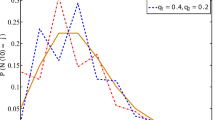Abstract
This paper extends the traditional hazard technique of estimating prepayment and default by allowing their baselines to be stochastic processes, rather than known paths of time, as is typically assumed. By working in the reduced form, this method offers an alternative to the empirical valuation of mortgages more easily implemented than the standard structural form approach of options pricing.
Similar content being viewed by others
References
Bélanger, A., Shreve, S. E., & Wong, D. (2003). A general framework for pricing credit risk, Working Paper.
Bielecki, T. R., & Rutkowski, M. (2002). Credit risk: Modeling, valuation and hedging. Springer.
Doucet, A., de Freitas, N., & Gordon, N. (2000). Sequential Monte Carlo methods in practice. Cambridge: Cambridge University Press.
Duffie, D. (1998). First-to-default valuation, Working Paper, Stanford University.
Duffie, D. (2001). Dynamic asset pricing theory (3rd edn). Princeton, New Jersey: Princeton University Press.
Duffie, D., & Lando, D. (2001). Term structure of credit risk spreads with incomplete accounting information. Econometrica, 69, 633–664.
Duffie, D., & Singleton, K. J. (1999). Modelling term structures of defaultable bonds. Review of Financial Studies, 12, 687–720.
Duffie, D., & Singleton, K. J. (2003). Credit risk. Princeton University Press.
Harrison, J., & West, M. (1997). Bayesian forecasting and dynamic models (2nd edn). Springer.
Jarrow, R. A., Lando, D., & Yu, F. (2003). Default risk and diversification: Theory and applications, Working Paper. Cornell University.
Jarrow, R., & Turnbull, S. (1995). Pricing derivatives of financial securities subject to credit risk. Journal of Finance, 50, 53–85.
Jegadeesh, N., & Ju, X. (2000). A non-parametric prepayment model and valuation of mortgage-backed securities. Journal of Fixed Income, 50–67.
Kau, J. B., & Keenan, D. C. (1995). An overview of the option theoretic pricing of mortgages. Journal of Housing Research, 6, 217–244.
Kau, J. B., Keenan, D. C., & Smurov, A. A. (2004). Reduced-form mortgage valuation, Working Paper.
Lando, D. (1998). On Cox processes and credit risky securities. Review of Derivatives Research, 2, 99–120.
Pearson, N. D., & Sun, T-S. (1994). Exploiting the conditional density in estimating the term structure: An application to the Cox, Ingersoll and Ross model. Journal of Finance, 49, 1279–1304.
Titman, S., & Torous, W. (1989). Valuing commercial mortgages: An empirical investigation of the contingent-claims approach to pricing risky debt. Journal of Finance, 44, 345–373.
Author information
Authors and Affiliations
Corresponding author
Rights and permissions
About this article
Cite this article
Kau, J.B., Keenan, D.C. & Smurov, A.A. Reduced Form Mortgage Pricing as an Alternative to Option-Pricing Models. J Real Estate Finan Econ 33, 183–196 (2006). https://doi.org/10.1007/s11146-006-9981-7
Published:
Issue Date:
DOI: https://doi.org/10.1007/s11146-006-9981-7




